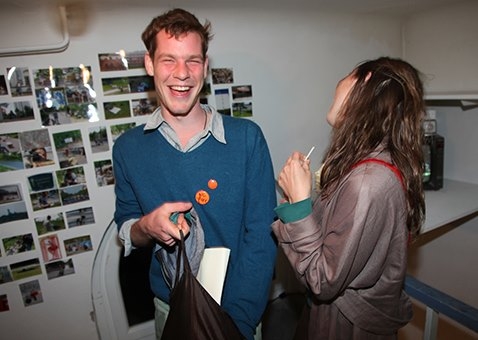wanderlust
Not Ha-ha Funny, But…

Have you ever had it happen that someone is telling you a joke, or something funny, and you prepare yourself to laugh—but when the punch line comes, the person telling you the joke is laughing so much that you feel swung not only away from laughter but towards a gravity to match their loop of levity, and you can’t help but frown? Well, that all seemed to be the case at the opening of <laughter>, the current exhibition at Apexeart. A lot of art can make you want to laugh to keep from crying (or rolling your eyes), but there were many solemn faces for a show almost entirely comprised of varieties of laughter.
Why So Serious?
This effect doesn’t seem unintentional, though. It’s the art equivalent of an Andy Kaufman routine: you’re exasperated more than entertained, but you still come away moved in some odd way. Take the installation of 25 speakers hanging from a large square space in the gallery, for instance—Jacqueline Hoang Nguyen’s For an Epidemic Resistance (2009). Its source material is the 1962 Tanganyika laughter epidemic, a hysterical outbreak of laughter in a small mission-run boarding school in Kashasha (part of what is now Tanzania). The laughter coming from the twenty-five speakers conveys this hysteria.
It bursts erratically from different parts of the room and, when it comes, it goes on for too long and with too much vigor. Nguyen quotes cultural theorist Marjolein’t Hart saying that laughter is a “weapon of the weak” in her explanation of the piece. Isolated in the white walls of a gallery, though, this kind of laughter seems more like a weak weapon. As unsettled as we may be, the laughter is disembodied enough to allow us to diagnose it, instead of possessing the critical force of real laughter in the face of power.
Funny Until Someone Gets Hurt
Real laughter in the face of power is, however, exactly what the video installation in the back of the gallery—Yoshua Okón’s Canned Laughter, 2009—displays. An old white-haired man stands conducting a choir of various workers from Ciudad Juárez, a Mexican city infamous for its exploitative maquiladora manufacturing plants. All of the choir is wearing uniforms with “Bergson” printed on them—possibly a reference to the famous French philosopher of laughter, Henri Bergson. As the conductor leads the group in laughing, ostensibly to manufacture laugh-tracks for sitcoms (in the fiction of the artwork), two screens zoom in on the faces of the workers.
What is fascinating here is the range of facial expressions among people producing the same emotive sound. Some look flat and unexpressive; others exhibit signs of discomfort and frustration; and then others offer further evidence that smiling and laughing can reflexively make you happy. By positioning you in the same gaze as the conductor, though, it is very unsettling to watch—I was reminded of philosopher Slavoj Zizek’s insistence, regarding coercive authority, that “the essential content of the superego’s injunction is ‘Enjoy!’”
The Last Laugh
The only work I really didn’t enjoy in either a provocative or a palliative way was Stuart Ringholt’s Naturist College (2013)—merely five framed pages pulled from the Big Penis Book. These barely-collaged works seemed flaccid—pardon the pun—compared to the other high-conceptual works. But of course, that was not all of Ringholt’s participation in the exhibition: on the Saturday after it opened, he led (whoever wanted to attend) in a nudist laughter workshop. Even now, I can’t suss out whether I’m jealous of his corporal freedom or if I think it’s all much ado about nothing. When Ringholt led a nudist tour through the Museum of Contemporary Art Australia last year, the New York Times asked some participants if the nakedness enhanced the art. “Not really,” one said, and another replied, “There was more focus on the art.”
Whatever the case; while I’ve written all this, contemplating whether being naked and laughing with others would be an art experience, that whole Saturday has passed and a number of people have already found out, thanks to Ringholt. Joke’s on me now, I guess.
- Apexart – “<laughter>” Group Show – May 23rd to July 27th, 2013 – Tue-Sat: 11am-6pm [Works not for sale]
Article by Christopher Robinson
Be the first to write a comment.
Your feedback


